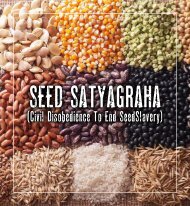Twenty years of failure
2cPDqsHeb
2cPDqsHeb
Create successful ePaper yourself
Turn your PDF publications into a flip-book with our unique Google optimized e-Paper software.
MYTH 1 “WE NEED GM CROPS TO FEED THE WORLD”<br />
There are no GM crops designed to increase yields. The evidence that GM crops increase yields<br />
compared to conventionally bred crops remains inconclusive 10 , with performance varying according to<br />
crop type, country/region and other local conditions (e.g. pest pressure in a given year, farmer training).<br />
GM crops can only increase yield by reducing losses to pests in <strong>years</strong> <strong>of</strong> high infestation, and this effect<br />
is not permanent as pesticide-producing crops lead to resistant ‘superbugs’ (see Myth 4.2). Studies<br />
examining GM crop yields have <strong>of</strong>ten failed to isolate the effects <strong>of</strong> GM technology from other factors,<br />
or to compare like-for-like farms.<br />
Those farms able to take on the increased costs associated with GM crops are <strong>of</strong>ten the biggest<br />
and most competitive farms to start with, while the non-GM farmers figuring in comparisons may be<br />
lacking credit, training and resources 11 . Genetic modification has not improved the yield potential (i.e.<br />
the maximum possible yield) <strong>of</strong> crops, as this depends more on the breeding stock used to carry the<br />
genes 12 . Conversely, reduced yields have been attributed to the GM insertion process. For example,<br />
Monsanto’s original Roundup Ready GM soya was found to yield 10% less, when compared against<br />
the latest high-performing conventional soya crops. This was thought to be equally due to both the<br />
gene or its insertion process and differences in breeding stock 13 .<br />
Meanwhile, a regional comparison shows that Western European countries have achieved higher<br />
average maize yields per hectare than the predominantly GM maize systems in the US, and Western<br />
Europe has also outperformed Canada’s GM rapeseed yields, suggesting that under similar conditions,<br />
the package <strong>of</strong> non-GM seeds and crop management practice in Western Europe is more conducive<br />
to driving yield gains than GM systems 14 .<br />
WHICH COUNTRIES GROW GM CROPS? 30<br />
13.4% Argentina<br />
Brazil 23.3%<br />
6.4% India<br />
6.4% Canada<br />
2.1% China<br />
2.1% Paraguay<br />
USA 40.3%<br />
6% Others<br />
TWENTY YEARS OF FAILURE | 5



